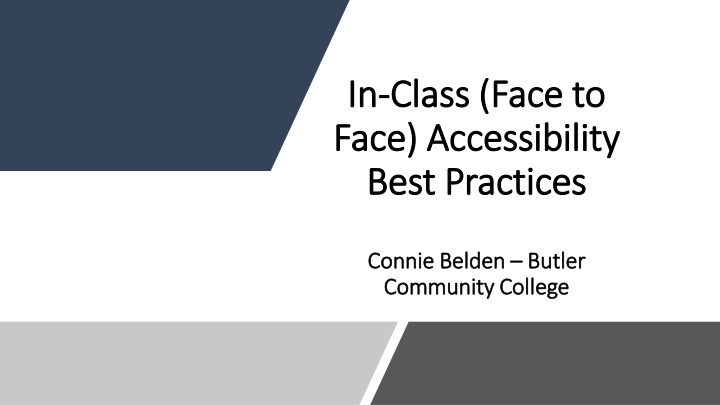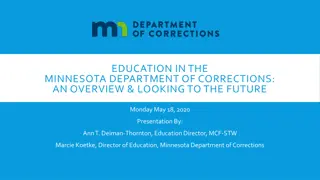
Classroom Accessibility Best Practices for Effective Learning
Discover why classroom accessibility is crucial for all students to achieve their full potential. Explore practical tips such as providing lecture outlines, using high contrast markers for whiteboards, and narrating content for better inclusivity. Enhance your classroom environment for a more inclusive educational experience.
Download Presentation

Please find below an Image/Link to download the presentation.
The content on the website is provided AS IS for your information and personal use only. It may not be sold, licensed, or shared on other websites without obtaining consent from the author. If you encounter any issues during the download, it is possible that the publisher has removed the file from their server.
You are allowed to download the files provided on this website for personal or commercial use, subject to the condition that they are used lawfully. All files are the property of their respective owners.
The content on the website is provided AS IS for your information and personal use only. It may not be sold, licensed, or shared on other websites without obtaining consent from the author.
E N D
Presentation Transcript
In In- -Class (Face to Class (Face to Face) Accessibility Face) Accessibility Best Practices Best Practices Connie Belden Connie Belden Butler Community College Community College Butler
Why think about classroom accessibility? 1. Some students may not self identify. 2. Some students may have temporary disabilities. 3. We want students to learn at their full potential and may not realize what is getting in their way (colors, hearing).
1. Provide an outline of class lectures to all students in advance of the class meeting highlighting materials that are covered. In-Class Lectures 2. For any paper handouts offer a digital version that is accessible. 3. Present new or technical vocabulary in a handout.
1. Whiteboards: Use high contrast markers (black and blue are recommended) unless other colors are necessary (avoid difficult colors, such as red) In-Class Lectures Standards for Visibility 2. Blackboards: Use high contrast chalk (white or yellow recommended) unless color is necessary. 3. Whiteboard and Blackboards: Use appropriate-sized letters (2 minimum height and then 1 additional per 10 of usable classroom size beyond 20 ).
PowerPoints: Use high contrast colors. Font size should be at least 18 pt. Use Sans Serif fonts (Arial). Use same standards as for whiteboards for letter size. Projector size, screen size, and resolutions can be different so you will have to judge for your size classroom. Be prepared to adjust font size if necessary. In-Class Lectures Standards for Visibility 1. 2. 3. 4. 5. 6.
In-Class Lectures Narrate and Describe All content presented visually: 1. Narrate/describe what is written on the blackboard/whiteboard/PowerPoint or other format. 2. Describe images and charts as you work through the material in class. 3. Enlarge text as needed.
In-Class Discussions 1. Rephrase or repeat student questions and comments. For important discussions (especially over testable materials), follow up with e-mail or announcement after class. 2.
Preview all videos for accuracy of closed captioning and text size. 1. Only show videos that have accurate and available closed captioning. 2. In-Class Media All new media purchases should be closed captioned. 3. 4. Your library might have some options (such as Films on Demand). Check publisher s materials for closed captioning, they may have other options. 5. Check closed captioning of any YouTube videos you plan to show. 6.
Supply study questions that demonstrate both the content and the format of upcoming tests. Explain what would be considered a good answer and why. In-Class Assessments and Exams When a test is not designed to measure students basic skills, allow appropriate tools such as a calculator, scratch paper, or a dictionary for exams.
Maintain copies (ideally in a digital format) of all content provided to students. Course Communication Provide the course syllabus online in your LMS by the first day of class. Communicate with students in a digital/accessible way that also keeps a record of those communications (school e- mail or LMS).
Provide a copy of these expectations and recommendations to any guest speakers so they can provide their lectures in an accessible way. A transcript of their speech would be helpful for those who are hearing impaired. Guest Speakers
People who encounter disabled students often feel apprehensive about discussing a disability in fear of offending the student. The best advice in working with a disabled student is TO TREAT THEM THE SAME AS NON-DISABLED STUDENTS. Do not feel awkward about approaching a student with questions about accommodations for their disability. Disability Etiquette
High A wide range of conditions may limit mobility and/or hand-function. Engagement Activities (such as AVID) When doing high engagement activities (such as AVID Techniques) you do need to consider the size of the area you are using and any adjustments that may need to be made so that a non-mobile person is able to participate in activities that require movement.
Questions or Comments or Comments? Choosing the Right Fonts for your PowerPoint Presentation. (2016, March 10). Retrieved from https://www.documentswithprecisio n.com/choosing-right-powerpoint- font/ Face to Face Standards Document Wichita State University. (2019). Retrieved from ksarn.org wp- content uploads 2019/06 Face- to-Face-Standards-2019 In-Class (Face to Face) Accessibility Best Practices. (2019). Butler Community College.
Thank you for attending Connie Belden cbelden@butlercc.edu


